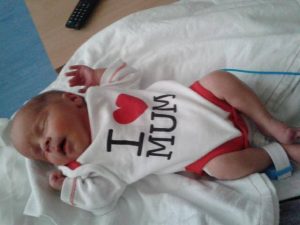
Diagnosis comes as a shock, regardless of whether the diagnosis happens during pregnancy, at birth, or at a later time. Common questions are:
Is there a cure?
It is important to understand that there are no direct cures for SA/CRS, but that does not mean the outlook is dim. In fact, the outlook is full of hope and promise. It is true that the missing part of the spine and spinal cord cannot be remade and inserted where they are missing or regrown. However, many medical treatments can improve the quality of life for people with SA/CRS. SA/CRS impacts everyone a little differently, so the type of treatment differs from person to person. Although doctors may be able to determine if this condition exists in some ultrasounds before birth, they cannot predict with any great accuracy the extent to which the condition will impact a child. Sometimes doctors provide a worst-case scenario. A doctor may say that the child will not breathe, sit up, or have any quality of life. These same children are breathing and sitting easily and having a vibrant and fulfilling life. Some children have no external signs of the condition at all, but others may have some physical differences. These physical differences do not mean that the child will be limited in independent functioning. Among our adult population are teachers, artists, musicians, actors, athletes, fashion designers, scientists, college students, business owners, and computer programmers. Individuals with SA/CRS can thrive. This website if full of real-life stories that give you a glimpse into the lives of individuals and families.
Is there a specialist who treats SA/CRS?
This condition is rare. There is no single specialist for this condition, but there are specialists who treat the parts of the body often impacted by this condition. These specialists are orthopedists, neurologists, urologists, and gastroenterologists. A listing of potential referrals that parents may obtain upon diagnosis is here. More specifics about these medical specialties can be found under the Medical tab of this website menu.
Is the condition life threatening?
It can be if not properly treated, and the primary concern is maintaining the health of the kidney and bowels. The life-threatening aspect of this condition is the health of bladder, bowels, and kidneys. Many treatments address bowel and bladder issues effectively, and ongoing monitoring of kidney health is essential. Any fever must be assessed to see if it stems from kidney infection. Kidney infections scar the kidney, gradually reducing its function. With good medical care, those with SA/CRS can live long and productive lives.
Some children have many other medical concerns not directly connected to SA/CRS. In some cases, these children do not live because of severe heart problems or severe problems with other vital organs. Sadly, these other conditions, those not directly associated with SA/CRS, can be life threatening. Some children are so significantly impacted by SA/CRS, particularly with organs such as the kidneys, intestines, bowel, and bladder, that they do not live. In most cases, however, even children with very pronounced physical impact of this condition can become thriving adults.
What caused SA/CRS?
The cause of SA/CRS is unknown. What we do know is that it is not directly caused by maternal diabetes as is sometimes claimed. There is some link between the condition of diabetes and SA/CRS, but this link is not clear enough to be called a direct cause. It is recommended, however, that those with maternal diabetes be monitored for this condition throughout their pregnancies. It is important to recognize that there are more children born with SA/CRS who do not have mothers with diabetes than there are who do have diabetic mothers. Whatever the cause, it is complex and multifactored and it is not the same cause for every person with SA/CRS. For more information about genetics, see the medical information on this site.
Will my child walk?
Many children with SA/CRS do walk, and some do not. The condition impacts each child differently. Whether your child walks or not does not impact the child’s ability to lead a productive life. Those who do use wheelchairs report leading fully independent lives. When walking is a reasonable goal, there are often surgical treatments to improve leg structure and function. There may be a need for equipment such as crutches, braces, and walkers. For more information about walking, read the selection All About Walking here on this website and information about walking under Orthopedics.
Will my child need a wheelchair?
The link All About Wheelchairs explains some perspectives that may surprise you about wheelchairs and covers everything you may need to know about ordering, selecting, and encouraging wheelchair skill development if your child does need a wheelchair. Some children with SA/CRS benefit from mobility options that include use of wheelchairs. Some children benefit from having both options available, perhaps walking shorter distances and using a wheelchair for longer distances. Some children walk, with bracing or crutches or independently. The mobility option that is best for your child will become clear over time.
What medical appointments should I expect at what ages?
Appointment types and schedules will vary from child to child because each individual is different. SA/CRS may be a part of a larger list of issues such as heart conditions and doctors will need to determine which issue needs to be addressed first. Some children have surgeries or treatments for specific issues shortly after birth. If speaking of the spinal condition itself, the impact on the kidney and bladder is usually the first concern, so urology is often an initial appointment. Your infant may have testing to determine the kidney function and bladder capacity. This testing may include an ultrasound of the bladder and kidney. A renal ultrasound may be done as early as 1 month of age to establish a baseline and then every year after that. For in depth information about urologic testing, download this information sheet available from the spina bifida association website.
Gastroenterology or colorectal centers that combine urology, gastroenterology, and gynecology may address bowel management. Also, if there are needs to evaluate the function of your child’s pelvic stability and lower limb functioning, your child will see an orthopedist. Some leg contractions can be addressed shortly after birth with taping and casting; long-term care may involve bracing and surgery for some children and adults. Concerns related to the spine and spinal cord may involve an orthopedist and a neurologist.
Will my child be in pain?
Children and adults with SA/CRS have the same aches and pains as anyone else. Additionally, those with SA/CRS may experience short periods of pain related to bladder infections, constipation, esophageal reflux, and hypersensitivity in certain parts of the body. Having a surgical procedure to improve function of the bladder, bowel, or legs may involve some pain in recovery. Usually the level of pain is not debilitating and can be resolved in a short time. Some individuals do struggle with ongoing symptoms of bladder spasms and take medications to address this issue. Children with pronounced spinal kyphosis or lordosis may experience pain when they lie on their backs or when pressed against a hard surface such as a car seat or highchair. Foam padding may resolve this issue. Older children and adults with SA/CRS do not typically describe their lives with words such as “suffering” or “painful” unless they have been taught to think that way about themselves. Instead, they usually lead active and productive lives.
Will my child grow “normally”?
Depending on how SA/CRS affects each individual, some children with SA/CRS will not differ in height or weight compared with children without the condition. Usually, however, a child with SA/CRS is small and may grow slowly. Children with SA/CRS have their own “normal” in terms of a growth curve. iSACRA has compiled a growth chart based on survey data and divided by category (see information under the Medical section of this website).
Force feeding and feeding tubes are not recommended for what seems to be slow growth unless there is a loss in weight over time or an indication of a problem with nutrient absorption. Some children with SA/CRS have very small lower limbs. Lower limbs equate to about half of a person’s body weight. Therefore, a “normal” growth curve must take into account that the child’s physical structure is much smaller. A very healthy child with SA/CRS impacting the spine at a high level, with very small pelvis and lower limbs may be as small as 4 lb at birth, 9 lb at 12 or 14 months of age, 25 lb in elementary school, 40 lb as a teenager, and 50 or 60 lb as an adult. For more information about height and weight, see our height and weight chart for more information.
A child with SA/CRS may have a stomach that is significantly smaller than for those without the condition. Organs may compete for space because of decreased trunk size (a small torso). Eating a full meal may not be possible or may be very uncomfortable. Instead, eating smaller meals more frequently through the day will provide the child with needed nutrition. Healthy food choices are essential.
Will my child be able to go to school, get a job, marry, have children….?
Probably yes. There is no reason for SA/CRS to prohibit your child from leading a full life and participating fully in society. Although there may be some hurdles in the process, problem solving and overcoming barriers encountered because of a physical disability give your child coveted talents such as innovation and tenacity. Most children with SA/CRS have no intellectual limitations. Most are able to make good friends in school and lead active social lives. They can aspire to and succeed in a vast number of occupations.
Fertility of those with SA/CRS is highly individual. For some, physical structures for reproduction are very small and may preclude giving birth. There are, however, those who have become parents without difficulty. See our stories of adults who are thriving under College, Career, and More.
How will I be able to afford my child’s care?
The fact that your child has SA/CRS does not always mean that costs for her or his care will be any greater than for any other child. For some, a few additional doctor’s appointments each year and medications from time to time do not impact the family medical budget. When more significant medical needs, and associated costs, arise, the costs differ widely from one country to another. In many countries, medical insurance or health plans cover most of the costs of care, including surgeries and wheelchairs. Additionally, in the United States, many children with SA/CRS qualify for Medicaid despite their parents’ incomes. Consult with a social worker at your local children’s hospital to find out about Medicaid in your state. Also, vocational funds may be available to assist with college tuition in some countries.
Grants are available for special equipment, even sports equipment such as hand-propelled bicycles (handcycles) and supplies. iSACRA has a program offering reimbursement of postage for equipment and supply exchange. There are organizations in some countries that assist with purchase of wheelchairs or other orthopedic equipment.
As you maintain connection with iSACRA, you will be able to network with other families and individuals to learn how to access financial supports. See the section on this website for Financial Resources.
